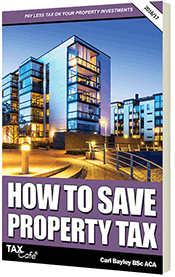Furnished Holiday Lets - Tax Planning Guide:
Big Tax Changes for Furnished Holiday Lets
FURNISHED HOLIDAY LETS currently enjoy a highly beneficial tax regime with many of the advantages of trading property. Qualifying property is eligible for Capital Gains Tax (‘CGT’) reliefs like entrepreneurs’ relief, rollover relief and holdover relief, allowing low tax sales and tax free transfers or replacements to take place; capital allowances are available on furniture and equipment in the property; losses can be set off against other income; and profits are qualifying ‘earnings’ for pension contributions.
The latest information can be found in our guide:
How to Save Property Tax
At the same time, profits escape National Insurance (although a few local Tax Offices wrongly insist on collecting Class 2) and the properties remain capable of qualifying as the owner’s main residence (usually by election) when occupied privately part of the time.
To qualify, the property must be available for letting to holidaymakers and tourists on a commercial basis for at least 140 days a year, it must actually be so let for at least 70 days and it must not normally be in the same occupation for more than 31 days during a ‘holiday season’ of at least seven months.
A similar range of reliefs are available to companies owning qualifying property, although this is less common, so we will concentrate on individual property owners in this article.
Holiday Lets Go International
Before the Budget on 22nd April, the property had to be in the UK but the regime has now been extended to qualifying property throughout the European Economic Area (‘EEA’): the 27 member states of the European Union plus Norway, Iceland and Liechtenstein.
This extension has been given backdated effect, meaning that qualifying property may be treated as if it qualified since it was first let as qualifying furnished holiday accommodation (or since the relevant country joined the EEA, if later).
The relevant CGT reliefs (including business asset taper relief on disposals before 6th April 2008) can therefore now be claimed on transfers and disposals taking place as far back as 6th April 2003, with a deadline of 31st January 2010 applying to the earliest claims.
Claims for capital allowances or to set losses off against other income of the same year must be made by amending your Tax Return. Under a special extension, you have until 31st July 2009 to submit an amended 2007 Tax Return incorporating these claims. 2008 Returns can be amended until 31st January 2010, as usual. Capital allowances can generally be claimed for most assets still in use in the property at the beginning of the return period (e.g. assets in use on 6th April 2006 for a 2007 Tax Return).
Whilst many people owning foreign property could benefit under the furnished holiday letting regime, it is important to realise that it is only available when the property is let out on a commercial basis as a genuine profit-making venture. Most foreign holiday homes will not meet this criterion.
There are also some drawbacks: neither the 10% wear and tear allowance nor the landlords’ energy saving allowance is available on qualifying furnished holiday accommodation. You do not have to claim furnished holiday letting treatment on a property outside the UK but, if you do, you will have to make all the appropriate adjustments, so look before you leap!
End of the Line
I’ve seen it before. Someone (usually the European Court of Justice) says the UK tax rules create an unfair advantage, so the Government says “OK then, we’ll take it off everyone”. That’s exactly what’s happening to the furnished holiday lettings regime. This year, it’s been extended to the EEA, next year it’s being taken away altogether.
Although we do not yet know what transitional rules might apply, owners of qualifying furnished holiday accommodation both in the UK and elsewhere may wish to consider taking action before 6th April 2010 to make the most of the regime while it still lasts, such as:
- Purchasing furniture and equipment costing up to £50,000 to obtain immediate tax relief under the annual investment allowance. The allowance is also available on part of the cost of new property, including plumbing and wiring. Where the allowance exceeds the owner’s net rental income for the year, the surplus can be set against other income.
- Transferring property to adult relatives whilst it is still possible to hold over the capital gain arising. This will also ensure that the property avoids Inheritance Tax, as long as you survive at least seven years, since it seems likely that it will also cease to qualify for business property relief. The transferee could even adopt the property as their main residence and thus avoid CGT permanently.
- Selling property whilst it still qualifies for entrepreneurs’ relief, thus giving rise to an effective CGT rate of just 10%.
- Replacing existing property with more desirable property whilst rollover relief is still available.
- Making pension contributions which qualify for tax relief by virtue of furnished holiday letting profits.
- Carrying out repairs and maintenance work and other qualifying business expenditure in order to generate losses which may be set off against other income.






